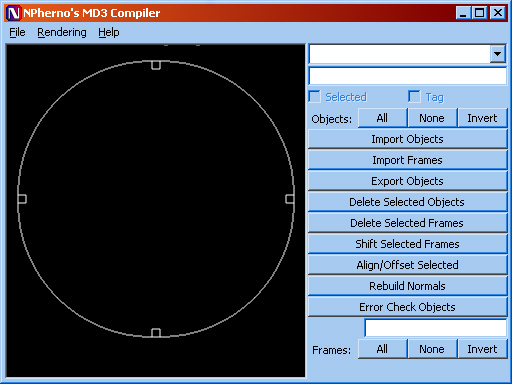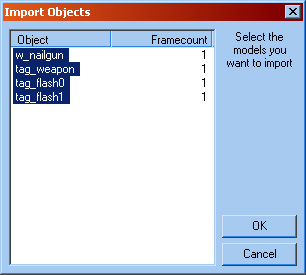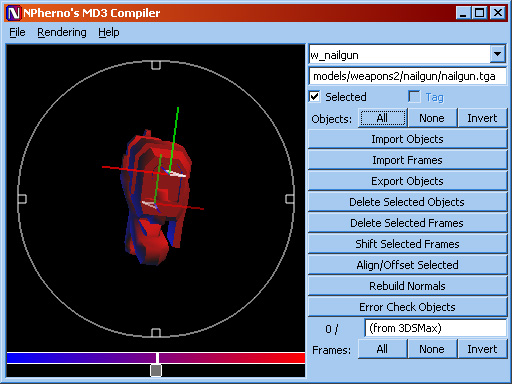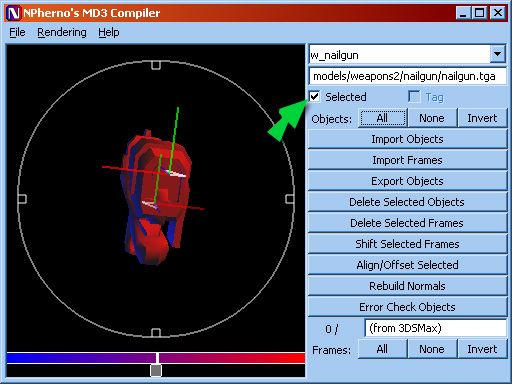Tutorials:Altering a material using NPherno MD3 Compiler
(Created page with "{{DISPLAYTITLE:Altering a skin-path using Npherno MD3 Compiler}} {{adopted |author=Tabun |source=http://www.tabun.nl/tutorials/md3skinpath_tutorial/ |Darkplaces engine }} ==W...") |
m |
||
| (12 intermediate revisions by 2 users not shown) | |||
| Line 1: | Line 1: | ||
| − | {{DISPLAYTITLE:Altering a skin-path using Npherno MD3 Compiler}} | + | {{DISPLAYTITLE:Tutorial: Altering a skin-path using Npherno MD3 Compiler}} |
| − | {{ | + | {{imported|Tabun|www.tabun.nl/tutorials/md3skinpath_tutorial/}} |
| − | | | + | {{grammar checked|darth}} |
| − | | | + | {{TOCRIGHT}} |
| − | | | + | |
| − | }} | + | |
==Whats needed== | ==Whats needed== | ||
| Line 11: | Line 9: | ||
==What's this about?== | ==What's this about?== | ||
| − | This tutorial gets you acquainted with | + | This tutorial gets you acquainted with a useful and concise tool titled 'Npherno's MD3 Compiler', which can be used to alter MD3 models. More specifically, it shows you exactly how to set or change the material of a surface. |
[[Darkplaces material system|Materialnames]] are stored in the MD3's themselves. When the game loads a model, it uses the embedded material name to load the proper material or texture. | [[Darkplaces material system|Materialnames]] are stored in the MD3's themselves. When the game loads a model, it uses the embedded material name to load the proper material or texture. | ||
| − | Altering MD3's can be tricky at first, but it's rather easy and doesn't take more than half a minute at most. | + | Altering MD3's can be tricky at first, but it's rather easy and doesn't take more than half a minute at most. |
==Step 1: Importing objects== | ==Step 1: Importing objects== | ||
| Line 36: | Line 34: | ||
{{important|Now, click the "All" button (located directly above "Import objects"). Make sure the checkbox in pic 4 is checked before you proceed!}} | {{important|Now, click the "All" button (located directly above "Import objects"). Make sure the checkbox in pic 4 is checked before you proceed!}} | ||
| − | [[File: | + | [[File:Tutorial_md3_04.jpg|Pic 4. After clicking "All"]] |
==Step 2: Altering the material== | ==Step 2: Altering the material== | ||
Now we can alter the material of any of the imported objects. | Now we can alter the material of any of the imported objects. | ||
| − | Usually, you'll find the MD3 only has one object. If you've | + | Usually, you'll find the MD3 only has one object. If you've selected more than one object in the import pop-up (see pic 2), there might be objects with a path need to be edited. |
Use the top-most dropdown-list to select an object (in this case, we can see that w_nailgun has been selected). The embedded path to the skin will be shown in the field immediately below it. You can edit the path now. | Use the top-most dropdown-list to select an object (in this case, we can see that w_nailgun has been selected). The embedded path to the skin will be shown in the field immediately below it. You can edit the path now. | ||
| Line 47: | Line 45: | ||
==Step 3: Final step== | ==Step 3: Final step== | ||
| − | Once you've edited the paths of all objects, it's time to export the model, saving all of your changes. | + | Once you've edited the paths of all the objects, it's time to export the model, saving all of your changes. |
Click "Export objects" and give the MD3 a nice name. You can overwrite the MD3 you imported without problems, by the way. | Click "Export objects" and give the MD3 a nice name. You can overwrite the MD3 you imported without problems, by the way. | ||
| − | A | + | A pop-up will appear asking for an "Internal name". Unless you're editing a player model, ignore this - leave it blank. |
Just click "OK". | Just click "OK". | ||
| − | |||
| − | |||
==Recap== | ==Recap== | ||
| − | + | To recap the tutorial stated above, here are the basic steps: | |
# Import objects | # Import objects | ||
# Alter name (remember, FORWARD slashes) | # Alter name (remember, FORWARD slashes) | ||
| Line 66: | Line 62: | ||
[[Category:Tutorials]] | [[Category:Tutorials]] | ||
| + | {{finished}} | ||
Latest revision as of 04:28, 23 November 2012
Original [www.tabun.nl/tutorials/md3skinpath_tutorial/ article] by Tabun
Contents |
[edit] Whats needed
- Npherno's MD3 compiler
- An MD3 model
[edit] What's this about?
This tutorial gets you acquainted with a useful and concise tool titled 'Npherno's MD3 Compiler', which can be used to alter MD3 models. More specifically, it shows you exactly how to set or change the material of a surface.
Materialnames are stored in the MD3's themselves. When the game loads a model, it uses the embedded material name to load the proper material or texture.
Altering MD3's can be tricky at first, but it's rather easy and doesn't take more than half a minute at most.
[edit] Step 1: Importing objects
Launch the MD3 Compiler. It's the "MD3Compile.exe" file. This is what you'll see:
Now, click the button labeled "Import objects", and select the MD3 you wish to alter. It shows the following popup:
Select all parts of the model, and click "OK". The model should now appear in the center as a red and blue set of objects.
The window should look something like pic 3.
[edit] Step 2: Altering the material
Now we can alter the material of any of the imported objects. Usually, you'll find the MD3 only has one object. If you've selected more than one object in the import pop-up (see pic 2), there might be objects with a path need to be edited.
Use the top-most dropdown-list to select an object (in this case, we can see that w_nailgun has been selected). The embedded path to the skin will be shown in the field immediately below it. You can edit the path now.
[edit] Step 3: Final step
Once you've edited the paths of all the objects, it's time to export the model, saving all of your changes. Click "Export objects" and give the MD3 a nice name. You can overwrite the MD3 you imported without problems, by the way.
A pop-up will appear asking for an "Internal name". Unless you're editing a player model, ignore this - leave it blank. Just click "OK".
[edit] Recap
To recap the tutorial stated above, here are the basic steps:
- Import objects
- Alter name (remember, FORWARD slashes)
- Export objects



